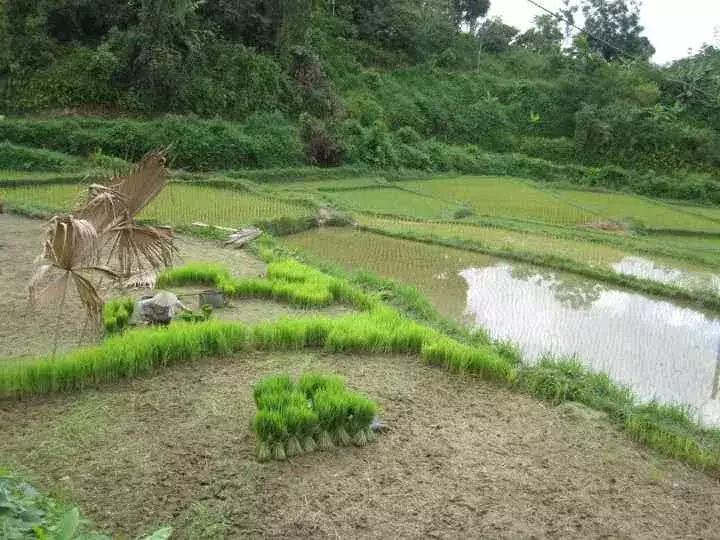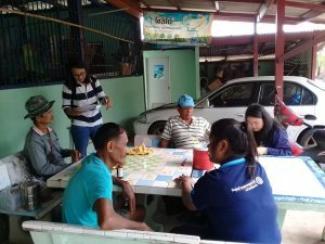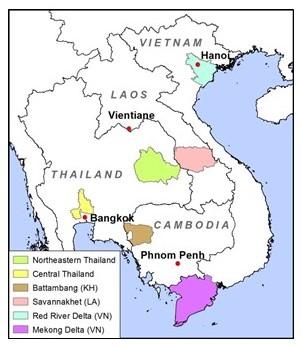Error message


East-West Center researchers recently launched a collaborative study on changes in rice farming in mainland Southeast Asia, supported by the U.S. National Aeronautics and Space Administration (NASA). Researchers are examining one of the most intriguing agricultural-development questions in the region—how have fewer, older farmers with fewer agricultural laborers and smaller farms managed to more than double total rice production over the past 20 years?
Rice (Oryza sativa) is one of the most widely harvested and nutritionally important foods in the world. It accounts for 20 percent of the world's calorie supply and is the staple food for more than 900 million people.
Rice is particularly important in mainland Southeast Asia. Farmers in Cambodia, Lao People’s Democratic Republic (PDR), Myanmar, Thailand, and Vietnam grow rice on more land than any other crop. Vietnam and Thailand are the top two rice exporters in the world. In fact, changes in rice production of either of these two nations would likely destabilize international rice markets, with clear ramifications for global food security.
Due to national policies that encourage rice production in Thailand and Vietnam, mainland Southeast Asia currently faces a glut of rice supplies and low market prices. Ongoing changes in the global economy, resource competition from other sectors, environmental changes, increasing commercialization of rice farming, and shifting international trade dynamics mean that both the incentives for growing rice and the ways in which rice is produced will require novel socioeconomic, environmental, and technological adaptations. Some traditional rice-growing areas may lose their comparative advantage, while others may become new centers for rice production. Changes in traditional gender roles associated with rice farming are also expected, as the demographic profile of rice farms shifts and the nonfarm sector expands in the course of economic growth.
Agricultural statistics from mainland Southeast Asia are scarce, but data from the Food and Agriculture Organization (FAO) and the World Bank suggest that between 1995 and 2015 the rural population of the region decreased by 13 percent as a proportion of the total population. Over the same period, agricultural employment as a proportion of total employment dropped by 19 percent. And over the 20-year period, the value of agricultural production decreased by10 to 28 percent as a proportion of Gross Domestic Product (GDP) in every country but Thailand, where it increase by 1.4 percent.
There has been very little expansion of the area under rice cultivation since the mid-1990s, but between 1995 and 2015, productivity per hectare (ha) increased in the countries of the region by an average of 205 percent. At the same time, the average size of farms decreased to about two ha, and the average age of farmers increased. These statistics raise one of the most interesting questions about agrarian change in the region: How did fewer, older farmers with smaller farms increase total rice production to such an extent?
In order to answer this question and to understand the implications of agrarian change for food security, livelihoods, development, and the environment, scientists and policymakers need a better understanding of:
- Long-term and regionally variable changes in rice production systems
- The effects on rice production systems of exogenous drivers, such as globalization, changing labor markets, precipitation, and temperature, and endogenous drivers, such as irrigation development and technology adoption
By rice production systems we mean the host of socioeconomic (labor availability, mean age of farmers, gender composition), physiographic (water availability, temperature), infrastructural (roads, dams, ponds) and technological (on-farm mechanization) conditions that affect rice production. With improved awareness of the relevant land-use processes and related socioeconomic patterns, we can develop more locally tailored strategies for sustained intensification of rice production, better investments in rice research and technology delivery, and more effective policy reforms that address livelihood and food security concerns of the most vulnerable populations in the region. Such findings may also have implications globally.
Satellite-based remote sensing offers the most practical means of monitoring changes the vast area of land under rice cultivation in mainland Southeast Asia, given the synoptic coverage, repeated and regular observation, and archival nature of satellite imagery. Questions remain, however, as to appropriate timing, number of satellite observations, spatial resolution of satellite imagery, and means of cloud cover mitigation for accurately capturing changes in factors such as rice production extent, growing seasons, and land management. And understanding the reasons for underlying changes in how land is managed and rice is produced, i.e., changes in land use rather than land cover, is challenging.
This project will use multi-sensor satellite imagery, regionally calibrated rice production modeling, and a host of primary and secondary data on demographic, socioeconomic, environmental, and infrastructural conditions collected at sub-district scales to rigorously characterize the ways in which rice production systems have changed and to approximate ways they may continue to change in response to globalization and changing conditions. Satellite imagery of rice producing areas has been available since 1995, making it possible to employ a space-for-time approach to monitor production systems across a range of scenarios.

While acknowledging the overwhelming importance of differences in the socioeconomic and biophysical regimes of the different study areas, this project will attempt to identify common socioeconomic and biophysical variables where similar patterns occur in different regions at different points in time. Some changes in the rice production system of central Thailand, for example, (introduction of direct seeding, mechanized harvesting, the establishment of industrial parks, and the spread of extensive urbanization and periurbanization) that occurred in the 1990s were echoed in the Red River Delta of Vietnam in the 2010s. Similarly, changes that occurred in northeast Thailand in the 2000s (direct seeding and mechanization) are beginning to appear in Lao PDR and Cambodia today.
This project will use a multi-disciplinary research program to monitor long-term changes and spatial variability of rice production systems, model past and current rice production, and identify variables highly correlated with change (socioeconomic, demographic, environmental, climatic, technological). Data will be produced for the period 1995 to 2018 at two nested scales (regional and local) across a total of six rice-growing regions in four mainland Southeast Asia countries (see map). The four countries and six regions are:
- Vietnam (Red River and Mekong River deltas)
- Thailand (northeast and central regions)
- Lao PDR (Savannakhet Province)
- Cambodia (Battambang Province)
A representative sample of communities within these regions will be chosen to investigate the various factors at play at the local level.
Principal Investigators
Jefferson M. Fox, Senior Fellow, East-West Center
Sumeet Saksena, Senior Fellow, East-West Center
Collaborating Scholars
Jamon Van Den Hoek, Assistant Professor of Geography, Environmental Sciences, and Marine Resource Management, Oregon State University, Eugene, Oregon, USA
Caitlin Kontgis, Geographer, Descartes Labs, Los Alamos, New Mexico, USA
Ian G. Baird, Associate Professor of Geography, Department of Geography, University of Wisconsin-Madison, Madison, Wisconsin, USA
Nathan Green, National University of Singapore, Singapore
Stephen Leisz, Associate Professor of Geography, Department of Geography, Colorado State University, Fort Collins, Colorado, USA
Kaspar Hurni, Senior Research Scientist, Centre for Development and Environment (CDE), University of Bern, Bern, Switzerland
Vo Quoc Tuan, Can Tho University, Can Tho, Vietnam
Tuyen Nghiem, National University of Vietnam, Hanoi, Vietnam
Kanokwan Manorom, Ubon Ratchathani University, Ubon Ratchathani, Thailand
Arunee Promkhambut, Khon Kaen University, Khon Kaen, Thailand
Ratha Seng, Battambang University, Battambang, Cambodia
Santi Piyadeth, Savannakhet University, Savannakhet, Laos

East-West Center researchers recently launched a collaborative study on changes in rice farming in mainland Southeast Asia, supported by the U.S. National Aeronautics and Space Administration (NASA). Researchers are examining one of the most intriguing agricultural-development questions in the region—how have fewer, older farmers with fewer agricultural laborers and smaller farms managed to more than double total rice production over the past 20 years?
Rice (Oryza sativa) is one of the most widely harvested and nutritionally important foods in the world. It accounts for 20 percent of the world's calorie supply and is the staple food for more than 900 million people.
Rice is particularly important in mainland Southeast Asia. Farmers in Cambodia, Lao People’s Democratic Republic (PDR), Myanmar, Thailand, and Vietnam grow rice on more land than any other crop. Vietnam and Thailand are the top two rice exporters in the world. In fact, changes in rice production of either of these two nations would likely destabilize international rice markets, with clear ramifications for global food security.
Due to national policies that encourage rice production in Thailand and Vietnam, mainland Southeast Asia currently faces a glut of rice supplies and low market prices. Ongoing changes in the global economy, resource competition from other sectors, environmental changes, increasing commercialization of rice farming, and shifting international trade dynamics mean that both the incentives for growing rice and the ways in which rice is produced will require novel socioeconomic, environmental, and technological adaptations. Some traditional rice-growing areas may lose their comparative advantage, while others may become new centers for rice production. Changes in traditional gender roles associated with rice farming are also expected, as the demographic profile of rice farms shifts and the nonfarm sector expands in the course of economic growth.
Agricultural statistics from mainland Southeast Asia are scarce, but data from the Food and Agriculture Organization (FAO) and the World Bank suggest that between 1995 and 2015 the rural population of the region decreased by 13 percent as a proportion of the total population. Over the same period, agricultural employment as a proportion of total employment dropped by 19 percent. And over the 20-year period, the value of agricultural production decreased by10 to 28 percent as a proportion of Gross Domestic Product (GDP) in every country but Thailand, where it increase by 1.4 percent.
There has been very little expansion of the area under rice cultivation since the mid-1990s, but between 1995 and 2015, productivity per hectare (ha) increased in the countries of the region by an average of 205 percent. At the same time, the average size of farms decreased to about two ha, and the average age of farmers increased. These statistics raise one of the most interesting questions about agrarian change in the region: How did fewer, older farmers with smaller farms increase total rice production to such an extent?
In order to answer this question and to understand the implications of agrarian change for food security, livelihoods, development, and the environment, scientists and policymakers need a better understanding of:
- Long-term and regionally variable changes in rice production systems
- The effects on rice production systems of exogenous drivers, such as globalization, changing labor markets, precipitation, and temperature, and endogenous drivers, such as irrigation development and technology adoption
By rice production systems we mean the host of socioeconomic (labor availability, mean age of farmers, gender composition), physiographic (water availability, temperature), infrastructural (roads, dams, ponds) and technological (on-farm mechanization) conditions that affect rice production. With improved awareness of the relevant land-use processes and related socioeconomic patterns, we can develop more locally tailored strategies for sustained intensification of rice production, better investments in rice research and technology delivery, and more effective policy reforms that address livelihood and food security concerns of the most vulnerable populations in the region. Such findings may also have implications globally.
Satellite-based remote sensing offers the most practical means of monitoring changes the vast area of land under rice cultivation in mainland Southeast Asia, given the synoptic coverage, repeated and regular observation, and archival nature of satellite imagery. Questions remain, however, as to appropriate timing, number of satellite observations, spatial resolution of satellite imagery, and means of cloud cover mitigation for accurately capturing changes in factors such as rice production extent, growing seasons, and land management. And understanding the reasons for underlying changes in how land is managed and rice is produced, i.e., changes in land use rather than land cover, is challenging.
This project will use multi-sensor satellite imagery, regionally calibrated rice production modeling, and a host of primary and secondary data on demographic, socioeconomic, environmental, and infrastructural conditions collected at sub-district scales to rigorously characterize the ways in which rice production systems have changed and to approximate ways they may continue to change in response to globalization and changing conditions. Satellite imagery of rice producing areas has been available since 1995, making it possible to employ a space-for-time approach to monitor production systems across a range of scenarios.

While acknowledging the overwhelming importance of differences in the socioeconomic and biophysical regimes of the different study areas, this project will attempt to identify common socioeconomic and biophysical variables where similar patterns occur in different regions at different points in time. Some changes in the rice production system of central Thailand, for example, (introduction of direct seeding, mechanized harvesting, the establishment of industrial parks, and the spread of extensive urbanization and periurbanization) that occurred in the 1990s were echoed in the Red River Delta of Vietnam in the 2010s. Similarly, changes that occurred in northeast Thailand in the 2000s (direct seeding and mechanization) are beginning to appear in Lao PDR and Cambodia today.
This project will use a multi-disciplinary research program to monitor long-term changes and spatial variability of rice production systems, model past and current rice production, and identify variables highly correlated with change (socioeconomic, demographic, environmental, climatic, technological). Data will be produced for the period 1995 to 2018 at two nested scales (regional and local) across a total of six rice-growing regions in four mainland Southeast Asia countries (see map). The four countries and six regions are:
- Vietnam (Red River and Mekong River deltas)
- Thailand (northeast and central regions)
- Lao PDR (Savannakhet Province)
- Cambodia (Battambang Province)
A representative sample of communities within these regions will be chosen to investigate the various factors at play at the local level.
Principal Investigators
Jefferson M. Fox, Senior Fellow, East-West Center
Sumeet Saksena, Senior Fellow, East-West Center
Collaborating Scholars
Jamon Van Den Hoek, Assistant Professor of Geography, Environmental Sciences, and Marine Resource Management, Oregon State University, Eugene, Oregon, USA
Caitlin Kontgis, Geographer, Descartes Labs, Los Alamos, New Mexico, USA
Ian G. Baird, Associate Professor of Geography, Department of Geography, University of Wisconsin-Madison, Madison, Wisconsin, USA
Nathan Green, National University of Singapore, Singapore
Stephen Leisz, Associate Professor of Geography, Department of Geography, Colorado State University, Fort Collins, Colorado, USA
Kaspar Hurni, Senior Research Scientist, Centre for Development and Environment (CDE), University of Bern, Bern, Switzerland
Vo Quoc Tuan, Can Tho University, Can Tho, Vietnam
Tuyen Nghiem, National University of Vietnam, Hanoi, Vietnam
Kanokwan Manorom, Ubon Ratchathani University, Ubon Ratchathani, Thailand
Arunee Promkhambut, Khon Kaen University, Khon Kaen, Thailand
Ratha Seng, Battambang University, Battambang, Cambodia
Santi Piyadeth, Savannakhet University, Savannakhet, Laos

